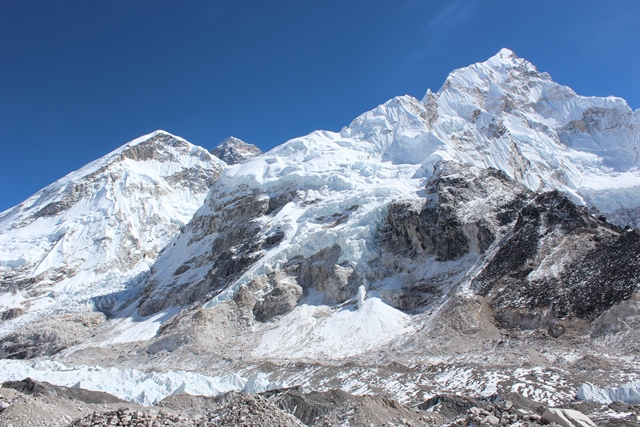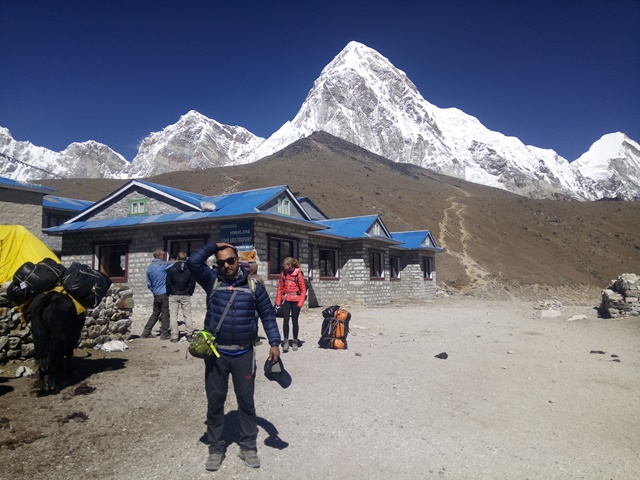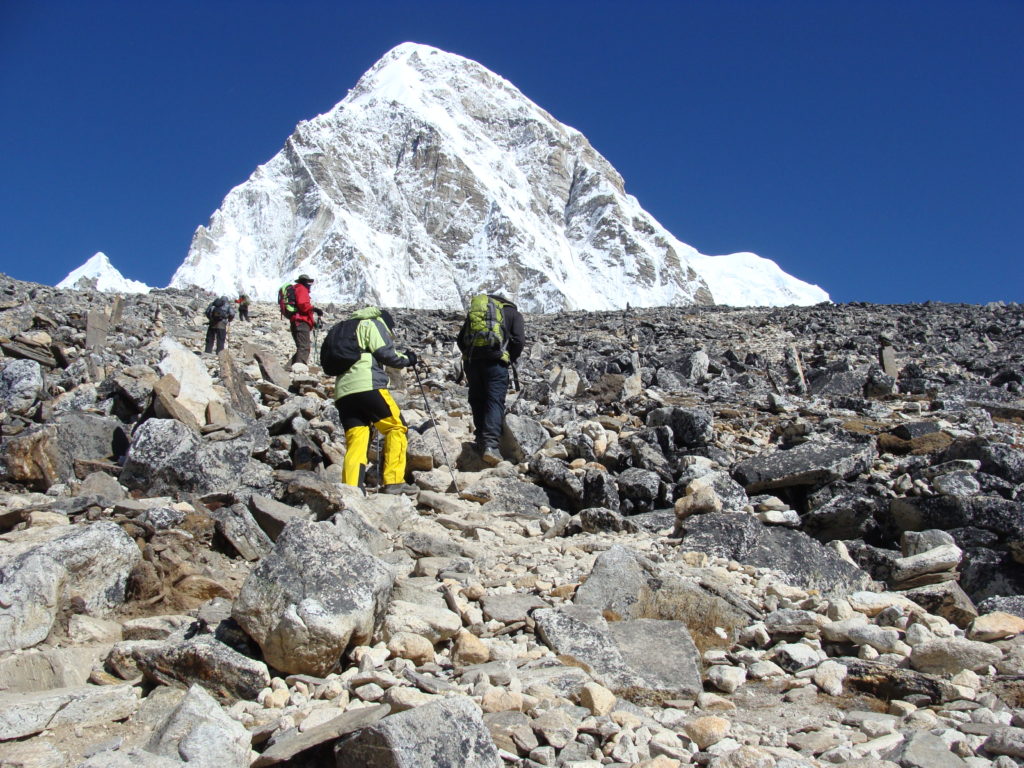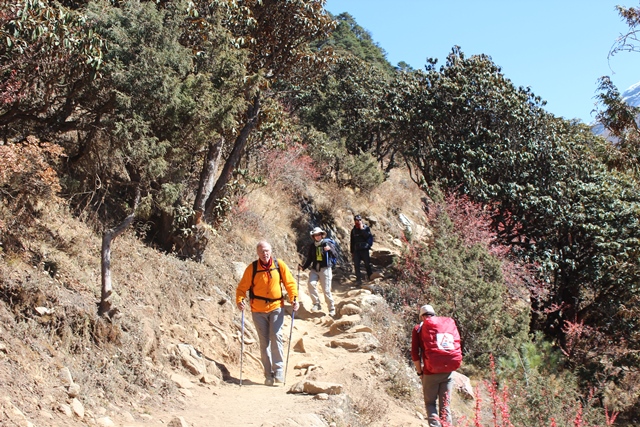All you Need to Know About Everest Base Camp(EBC) trek
17 Feb 2023 Santosh Gauli

Trekking to Everest Base Camp is an iconic and challenging adventure that attracts thousands of visitors every year. Located in the Khumbu region of Nepal, the trek takes you through some of the most spectacular mountain scenery in the world, including the towering peaks of Mount Everest, Lhotse, Nuptse, and Ama Dablam.
The trek to Everest Base Camp typically takes around 12-14 days, depending on the itinerary and the level of fitness of the trekker. The trail starts in the town of Lukla, which can be reached by a short flight from Kathmandu, and follows the Dudh Kosi River through a series of picturesque Sherpa villages.
One of the biggest challenges of the trek is the altitude, as you will be ascending to a height of 5,364 meters (17,598 feet) at Base Camp. Altitude sickness can affect anyone, regardless of age, gender, or fitness level, and it’s important to take the necessary precautions to minimize the risk of this potentially serious condition.
The trek to Everest Base Camp requires a moderate level of fitness, and it’s important to prepare yourself physically and mentally for the challenges of the trek. Regular exercise, including hiking, running, and cycling, can help to improve your stamina and endurance.
When planning your trek, it’s important to choose a reputable guide or trekking agency, who can provide you with the necessary support and guidance throughout your journey. They can also help you with logistics such as permits, accommodation, and transportation.
The best time to trek to Everest Base Camp is during the spring (March to May) and autumn (September to November) seasons, when the weather is dry and mild, and the skies are usually clear. However, these seasons are also the busiest, so it’s important to book your trek well in advance.
In addition to the stunning mountain scenery, trekking to Everest Base Camp also provides an opportunity to learn about the local culture and customs of the Sherpa people. You’ll have the chance to visit monasteries, experience traditional cuisine, and interact with the friendly and hospitable locals.
In summary, trekking to Everest Base Camp is a challenging and rewarding adventure that requires proper preparation and planning. With the right mindset, physical fitness, and support, it can be a life-changing experience that you will never forget.
How to be prepare for EBC trek?

Preparing for a trek to Everest Base Camp requires careful planning and preparation to ensure that you are physically and mentally ready for the challenges of hiking at high altitude. Here are some tips to help you prepare for your journey:
- Start training early: Building up your endurance and strength is key to successfully completing the trek. Start a training program several months before your trip that includes regular cardio exercise, such as hiking, running, cycling, or swimming, as well as strength training exercises that target your legs and core.
- Get a medical check-up: It’s important to make sure that you are physically fit enough to undertake the trek. Get a medical check-up before your trip to ensure that you don’t have any underlying health conditions that could make the trek more difficult or dangerous.
- Acclimate yourself to altitude: Altitude sickness is a real risk when trekking at high altitudes. To prepare for this, consider taking a practice hike or two in high-altitude areas to acclimate your body to the decreased oxygen levels.
- Pack the right gear: Packing the right gear is crucial for a successful trek to Everest Base Camp. This includes comfortable and durable hiking boots, warm clothing for the chilly nights, a waterproof jacket, sunscreen, and a hat. Also, make sure to bring a good quality backpack that can hold all your gear.
- Consider hiring a guide or porter: Trekking to Everest Base Camp can be challenging, especially if you’re carrying a heavy backpack. Consider hiring a guide or porter to carry your gear and provide you with support throughout the journey.
- Stay hydrated and well-fed: Staying hydrated and well-fed is essential for trekking at high altitudes. Make sure to bring enough water, snacks, and high-energy foods to keep you fueled throughout the trek.
- Have a flexible itinerary: The weather conditions can be unpredictable in the mountains, so it’s important to have a flexible itinerary that allows for changes in the schedule if necessary. Be prepared for delays or cancellations due to bad weather and plan accordingly.
In summary, preparing for a trek to Everest Base Camp requires a combination of physical training, acclimation, proper gear, and flexibility. By taking the time to properly prepare, you can ensure that you have a safe and enjoyable trekking experience.
Supplements to prepare for Everest Base Camp & Kalapthar trek
When preparing for a high-altitude trek, supplements can be an important addition to your diet. Here are some supplements that may help you prepare for the challenges of hiking at high altitude:
Iron: Iron is essential for the production of red blood cells, which carry oxygen to your muscles and organs. Iron deficiency can lead to fatigue and decreased endurance, which can be especially problematic at high altitudes where oxygen is scarce. Consider taking an iron supplement or eating iron-rich foods, such as red meat, beans, and leafy greens, before your trek.
Vitamin C: Vitamin C is important for maintaining a healthy immune system, which can be compromised at high altitudes. It can also help your body absorb iron, which can be beneficial for endurance. Consider taking a vitamin C supplement or eating vitamin C-rich foods, such as citrus fruits and bell peppers, before your trek.
B-complex vitamins: B vitamins are important for energy metabolism and can help reduce fatigue and boost endurance. Consider taking a B-complex vitamin supplement or eating B vitamin-rich foods, such as whole grains and leafy greens, before your trek.
Magnesium: Magnesium is important for muscle function and can help reduce muscle cramps, which can be common at high altitudes. Consider taking a magnesium supplement or eating magnesium-rich foods, such as nuts and leafy greens, before your trek.
Rhodiola: Rhodiola is an herb that has been shown to improve endurance and reduce fatigue. It may also help improve mental performance and reduce the symptoms of altitude sickness. Consider taking a rhodiola supplement before and during your trek.
It’s important to note that supplements should not be used as a substitute for a healthy diet and regular exercise. Always consult with a healthcare professional before starting any new supplement regimen. Additionally, it’s important to stay hydrated and well-fed during your trek, as proper nutrition and hydration are essential for a safe and successful journey at high altitude.
How do you Train for High Altitude and Low Oxygen:
Training for high altitude and low oxygen can be challenging, but there are several strategies you can use to prepare your body for the rigors of hiking at high altitude. Here are some tips to help you train for high altitude and low oxygen:
Cardiovascular training: Hiking at high altitude can be a physically demanding activity, so it’s important to build cardiovascular endurance through activities such as hiking, running, or cycling. Aim to exercise for at least 30 minutes a day, 3-4 times a week, gradually increasing the duration and intensity of your workouts.
Strength training: Building muscular strength can help you carry your backpack and maintain good posture while hiking, which can be especially important at high altitude where the air is thin. Incorporate strength training exercises, such as squats, lunges, and shoulder presses, into your workout routine.
Interval training: Interval training can help increase your body’s ability to process oxygen and reduce the risk of altitude sickness. Try doing high-intensity interval training (HIIT) workouts, which involve alternating periods of high-intensity exercise with periods of rest.
Altitude simulation: If you live in an area with low altitude, you can simulate high altitude by training with a mask or using an altitude training machine. This can help your body adapt to the reduced oxygen levels before your trek.
Breathing exercises: Breathing exercises, such as diaphragmatic breathing or pursed lip breathing, can help you increase lung capacity and improve oxygen uptake. Incorporate breathing exercises into your workout routine or practice them daily to prepare for high altitude.
Hydration and nutrition: Proper hydration and nutrition are essential for training at high altitude. Make sure to drink plenty of water and eat a well-balanced diet that includes plenty of protein, complex carbohydrates, and healthy fats.
It’s important to gradually increase your training intensity and volume to avoid injury and overtraining. Be patient with your progress and listen to your body, and always consult with a healthcare professional before starting any new training regimen.
What about walking trails from Lukla to EBC and Kalapathar?

The trek to Everest Base Camp (EBC) and Kalapathar from Lukla involves walking along a well-maintained trail that passes through several villages and provides stunning views of the Himalayan Mountains . The trail is generally easy to follow and not overly difficult, although it can be challenging due to the high altitude and cold temperatures. During the hike, trekkers will experience a variety of terrain, including steep ascents and descents, rocky paths, and even snow-covered trails depending on the season. Additionally, there are several rest stops along the way, where trekkers can rest and refuel for the next leg of the journey.
Everest base camp trek during December:
Trekking to Everest Base Camp during December can be a challenging yet rewarding experience. December falls under the winter season in Nepal, which means that temperatures can drop below freezing, and snowfall is common. However, the trails are less crowded, and the clear winter skies offer stunning views of the Himalayan peaks.
It is essential to pack warm clothing and gear suitable for cold weather conditions. The trek may take longer as snow and ice can make the trails slippery and more challenging to navigate. It is also important to acclimatize properly to avoid altitude sickness.
Overall, the Everest Base Camp trek during December can be a unique and memorable experience for those willing to brave the winter weather.
Everest base camp trekking during spring and Autumn season:
Trekking to Everest Base Camp during the spring and autumn seasons is considered the best time to go. In Nepal, spring starts from March to May, and autumn is from September to November.
During these seasons, the weather is relatively stable, with clear skies and mild temperatures, making the trekking experience comfortable and enjoyable. The trails are also dry, making it easier to navigate, and the mountain views are spectacular.
The spring season sees a bloom of colorful rhododendron flowers, which adds to the natural beauty of the area, while the autumn season offers a clear view of the peaks with moderate temperatures. The trek may be crowded during these seasons, but the experience is worth it.
It is important to book early as many people prefer to trek during these seasons, and make sure to pack suitable clothing and gear for the temperatures, which can vary throughout the day. Proper acclimatization is still important to avoid altitude sickness.
EBC trek trekking insurance:
Trekking insurance is essential for anyone planning to undertake the Everest Base Camp trek. It is important to have insurance that covers emergency medical evacuation, medical expenses, accidental injuries, and repatriation.
The trek can be physically demanding, and the altitude can make it more challenging, which increases the risk of altitude sickness and other injuries. Therefore, it is crucial to have insurance that covers helicopter evacuation in case of an emergency.
It is recommended to purchase trekking insurance from a reputable company that specializes in adventure sports or trekking insurance. Ensure that the policy covers high altitude trekking and that it is valid in Nepal.
Before purchasing insurance, it is important to read and understand the policy’s terms and conditions, coverage, and exclusions. It is also a good idea to keep a copy of the policy document and emergency contact information with you while trekking.
Altitude sickness symptoms and their solutions:
Altitude sickness, also known as Acute Mountain Sickness (AMS), is a common condition that occurs when people ascend to high altitudes too quickly. Here are the symptoms of altitude sickness and some solutions:
Headache: One of the most common symptoms of altitude sickness is a headache. The solution is to rest and take over-the-counter painkillers such as paracetamol.
Nausea and Vomiting: Another common symptom is feeling nauseous and vomiting. The solution is to rest, drink plenty of fluids, and take anti-nausea medication.
Dizziness: Feeling dizzy or light-headed is another symptom of altitude sickness. The solution is to rest, hydrate, and move slowly.
Fatigue: Feeling tired or weak is common at high altitudes. The solution is to rest and drink plenty of fluids.
Shortness of breath: Difficulty breathing or shortness of breath is a symptom of altitude sickness. The solution is to rest and take deep breaths. If the symptom persists, descend to a lower altitude.
Loss of appetite: High altitude can also cause loss of appetite. The solution is to eat small, frequent meals and drink plenty of fluids.
Insomnia: Difficulty sleeping is common at high altitudes. The solution is to rest and take over-the-counter sleep aids if necessary.
Preventing altitude sickness is essential by acclimatizing to the altitude slowly, staying hydrated, eating a balanced diet, and avoiding alcohol and smoking. If the symptoms of altitude sickness worsen, it is recommended to descend to a lower altitude and seek medical attention.
Lukla flight and cancellation:
The Lukla flight is a crucial aspect of the Everest Base Camp trek as it is the starting point for most trekkers. However, flights to Lukla can be unpredictable, and cancellations are common due to weather conditions, particularly during the monsoon and winter seasons.
If a Lukla flight is canceled, the airline company will usually provide an alternative flight or a refund of the ticket. It is recommended to book the Lukla flight with a reputable airline company to minimize the risk of cancellations.
In case of cancellations, it is important to have some buffer days in the itinerary to accommodate the changes in the trek schedule. It is also important to keep in touch with the trekking agency and follow their advice on rescheduling the trek.
It is advisable to have travel insurance that covers flight cancellations and delays to avoid financial losses. Finally, it is important to stay positive and flexible, as flight cancellations are common, and alternative plans may need to be made.
Rest day at Namche and Dingboche before reaching EBC:

Taking a rest day at Namche Bazaar and Dingboche before reaching Everest Base Camp is a common practice among trekkers.
Namche Bazaar, located at 3,440 meters, is the last major town before reaching Everest Base Camp. The rest day in Namche allows trekkers to acclimatize to the altitude, explore the town, and enjoy the local culture.
Dingboche, located at 4,400 meters, is the last settlement before the final push to Everest Base Camp. Taking a rest day in Dingboche allows trekkers to acclimatize to the high altitude, rest, and prepare for the final ascent.
During the rest days, it is important to stay hydrated, eat a balanced diet, and avoid overexertion. Trekkers can explore the town, visit local monasteries, or hike to nearby viewpoints to acclimatize to the altitude.
Taking rest days is essential to prevent altitude sickness and increase the chances of successfully reaching Everest Base Camp. It is important to follow the trekking agency’s advice on rest days, itinerary, and acclimatization.
Everest Base Camp Trek 8 Days cost for 2023:
The cost of the Everest Base Camp Trek can vary depending on a number of factors such as the season, the type of trekking package, the level of accommodation, and the inclusion of additional activities. However, as a rough estimate, an 8-day Everest Base Camp Trek in 2023 can cost between $1200 and $2000 per person.
The cost of the trekking package generally includes the following:
- Airport transfers
- Domestic flights (Kathmandu-Lukla-Kathmandu)
- Trekking permits (Sagarmatha National Park Permit and TIMS Card)
- Accommodation during the trek (tea houses or lodges)
- Meals during the trek (breakfast, lunch, and dinner)
- Trekking guide and porter services
- In addition to the above, the cost may also include extras such as travel insurance, trekking equipment rental, and additional activities such as a helicopter tour of the Everest region.
It is important to note that these costs are estimates and can vary depending on the specific trekking package, the season, and the company you choose. It’s best to do thorough research and compare packages before making a decision.

